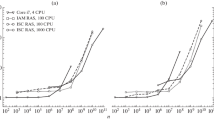Abstract
An approach to structural analysis is presented in which object-oriented data structures make it possible to arrange computational tasks in a unique fashion. A general matrix-free solution algorithm for use with arbitrary assemblages of linearly connected objects is presented, followed by an overview of a prototype structural analysis program built entirely on such an object-oriented data structure. The principal result is due to the flexibility inherent in this type of data structure, which makes it possible to analyze structural models incrementally as they are developed. Although certainly useful in traditional contexts, the parallel nature of the scheme could be particularly powerful in a multiprocessor environment.
Similar content being viewed by others
References
Bishop P. (1986) Fifth Generation Computers. New York: Wiley
Moon, D.A. (1987) Symbolics architecture. Computer 20, 43–52
Booch, G. (1986) Object-oriented development. IEEE Softw. 12, 211–221
Stefik, M.; Bobrow, D. (1986) Object-oriented programming: Themes and variations. AI Magazine, 6, 40–62
Yonezawa, A., Tokoro, M. (Eds.) (1987) Object-Oriented Concurrent Programming. Cambridge, MA: MIT Press
Gastinel, N. (1970) Linear Numerical Analysis. New York: Academic Press
(1987) Symbolics Common List-Language Concepts. Cambridge, MA: Symbolics, Inc.
Steele, G.L. (1984) Common LISP—The Language. Minneapolis, MN: Digital Press
Irons, B.M. (1970) A frontal solution program for finite element analysis. Int. J. Numer. Meth. Eng. 2, 5–32
Cannon, H.I. (1980) Flavors. Technical Report, MIT Artificial Intelligence Lab. Cambridge, MA
Author information
Authors and Affiliations
Rights and permissions
About this article
Cite this article
Miller, G.R. A LISP-based object-oriented approach to structural analysis. Engineering with Computers 4, 197–203 (1988). https://doi.org/10.1007/BF01213981
Issue Date:
DOI: https://doi.org/10.1007/BF01213981




